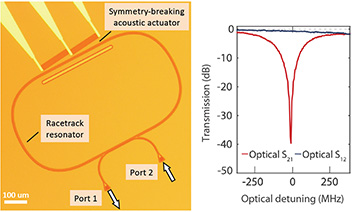 Left: Photograph of a lithium niobate isolator. Right: Demonstration of linear optical isolation with record-setting figure of merit. [Enlarge figure]
Left: Photograph of a lithium niobate isolator. Right: Demonstration of linear optical isolation with record-setting figure of merit. [Enlarge figure]
Optical isolators, found at the front end of nearly every benchtop laser system, are widely used for unidirectional photon transport. They function as two-port devices that are transparent to light one-way while blocking it in the reverse direction. Commercial isolators are exclusively produced using the magneto-optical Faraday rotation effect, but this approach is not easily implemented within integrated photonics due to fabrication constraints, the need for magnetic biasing, and the optical loss associated with magneto-optic materials. The absence of low-loss isolators in integrated photonics is therefore widely recognized as a major challenge.
Less often discussed is that magneto-optic materials also have strong chromatic dependence; as a result, adapting to different wavelengths often forces a complete change of the material and its magnetic biasing. Non-magnetic and practical alternatives will be crucial to help drive miniaturization of photonic interfaces for quantum applications and for atom–photon integration,1 since those systems can be highly sensitive to magnetic fields. In recent years, researchers have investigated alternative approaches using various forms of spatio-temporal biasing, but none are fundamentally able to produce isolators with ultralow insertion loss in the transmitting direction.
This year, we demonstrated an electrically driven optical isolator design that combines the unbeatable transparency of a high-quality dielectric waveguide with near-perfect attenuation in the blocking direction.2 The isolator works by treating the optical modes of a lithium niobate racetrack resonator as a two-level atom, in which we introduce a photonic equivalent of Autler–Townes splitting (p-ATS) to modify the optical density of states. Our implementation generated the p-ATS using a piezoelectrically launched acoustic wave that breaks the symmetry between available forward and backward cases, in a mechanism similar to previous work from our lab.3 We showed that, when the acousto-optic coupling is sufficiently strong, the asymmetry in the optical density of states is so large that ideal isolation behavior is produced within the waveguide.
Using this approach, we demonstrated isolators at wavelengths an octave apart at both 1550 nm (for telecom applications) and 780 nm (for applications such as probing rubidium transitions), starting from the same lithium-niobate-on-insulator substrate and with the same fabrication process.2 The devices achieved linear optical isolation—that is, isolation with no frequency shift—with only 0.65 dB insertion loss and greater than 39 dB blocking contrast, at par with commercial off-chip magneto-optic isolators.
Importantly, our results outperform the best previously demonstrated on-chip magneto-optic isolators4 on both insertion loss and the isolator figures-of-merit (our device showed 60 dB contrast per 1 dB insertion loss). The results also demonstrate a lithographically defined wavelength adaptability that cannot be achieved with any magneto-optic isolator.
Researchers
Ogulcan E. Örsel, Donggyu Sohn and Gaurav Bahl, University of Illinois at Urbana-Champaign, Urbana, IL, USA
References
1. J. Kitching. Appl. Phys. Rev. 5, 031302 (2018).
2. D.B. Sohn et al. Nat. Photon. 15, 822 (2021).
3. D.B. Sohn et al. Nat. Photon. 12, 91 (2018).
4. W. Yan et al. Optica 7, 1555 (2020).
